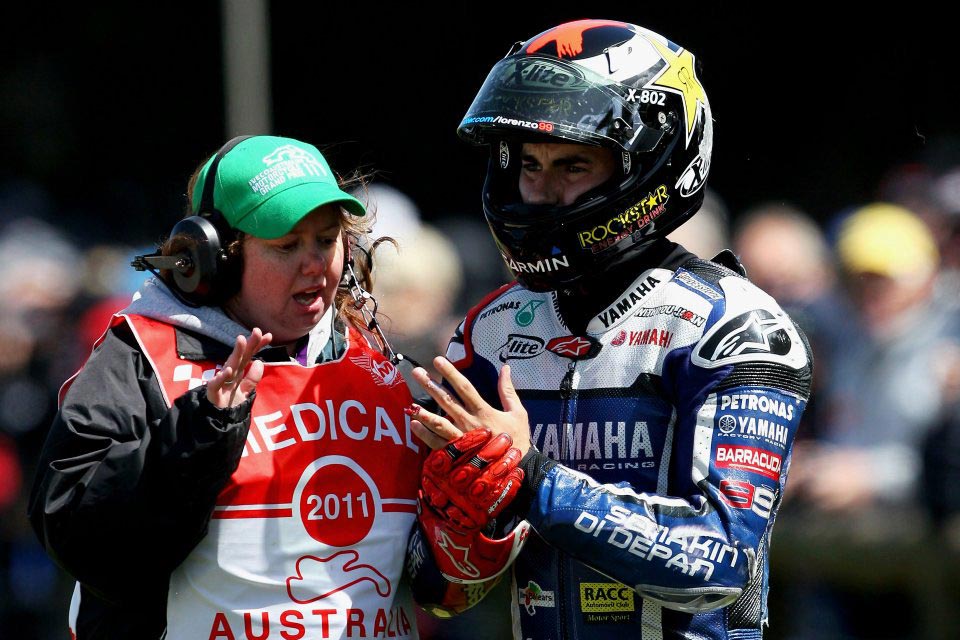Sounds like youve got it all figured out. You should be in Italy right now.

A wsb Duc is not a MotoGP Duc, both have 2 wheels are about as far as it goes for similarities.
Yea and the most significant difference is the tire brand which is not part of the actual bike.
Sorry, there was no movie version, you are going to have to read ;-)
http://www.motomatters.com/analysis/2011/08/08/the_trouble_with_the_ducati_desmosedici_.html
Read the article but if not then here is a piece of it.
It The Rider?
The biggest variable which has changed between 2010 and 2011 is the departure of Casey Stoner and the arrival of Valentino Rossi. Though Rossi is now riding a heavily modified machine (the GP11.1, as it has been dubbed, is a destroked version of the 2012 Desmosedici, its capacity reduced to 800cc to make it legal for 2011), the bike he rode until Assen was not much changed from the bike Stoner left behind at Valencia in 2010. The bike had a modified triple clamp, a slightly different swingarm, and a slightly revised front chassis. The biggest changes have been in the field of electronics, Rossi and his crew helping to provide a much more user-friendly engine response package, introduced after Estoril.
So if Stoner made the Ducati work, then surely the problem must be with Rossi, right? Though that might appear to be the logical conclusion, that grossly oversimplifies a complicated situation. Just 9 months ago, with a weakened shoulder that left him struggling, Rossi was still capable of winning races and scoring regular podiums. He was poetry to watch, flowing over the Yamaha M1 and able to put it just about where he wanted. In the 11 races after returning from the leg he broke at Mugello, and still struggling with the shoulder injury he picked up in a training crash in April, Rossi was on the podium 7 times, including 1 win. Riders simply do not lose that kind of speed over the winter break, not unless they suffer a career-threatening injury.
From the moment he swung his leg over the Ducati, Rossi was immediately miles off the pace. He ended the two-day test 1.7 seconds off the pace of the fastest man, Jorge Lorenzo. Three days earlier, in the race, Rossi's fastest lap had been just a few hundredths slower than Lorenzo's. Worse still, Rossi looked nothing like himself on the bike. Several observers commented that it was as if someone had sneaked into Rossi's motorhome, stolen his leathers and helmet, walked in through the back of the pits and onto the Ducati without anyone noticing he was not Rossi. At that first test in Valencia, Rossi looked like a journalist riding the bike, someone far less comfortable or able easing his way around the track.
Rossi was not the only rider to undergo an overnight transformation. Loris Capirossi jumped off the Rizla Suzuki and onto the Pramac Ducati and went nowhere, while Randy de Puniet has been transformed from the man who regularly scored top 6 results on the LCR Honda to a rider who can barely make it into the top 10 on the Pramac Desmosedici. With the Ducati's history of destroying riders' reputations - along with their self-confidence - Rossi is just another casualty in the long list that started with Marco Melandri.
The startling difference between Rossi's times from this year and those from last year is one clue that the problem is not with the rider. At Laguna Seca, where comparable temperatures prevailed between the 2010 and 2011 events, Rossi was 14 seconds slower this year than on the Yamaha. At the 2010 event, Rossi was still using crutches, the US round being only his second race since returning after breaking his leg at Mugello, some 8 weeks' beforehand. But the key piece of evidence that the problem is the bike and not the rider is the times of Nicky Hayden: the American was also 14 seconds slower at Laguna in 2011 than he was in 2010.













